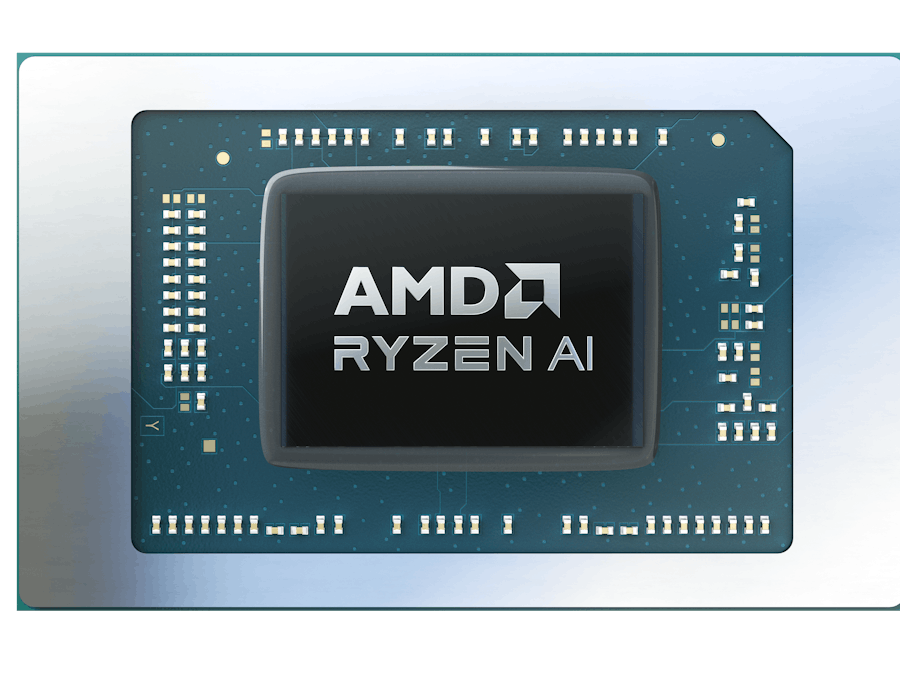The AMD Ryzen™ 7040 series processors are built on cutting-edge 4nm process node to deliver outstanding performance and battery life in an ultrathin laptop. Select models offer the new Ryzen AI Engine, the first dedicated AI engine on a Windows x86 processor[1]. Ryzen AI technology is designed to deliver AI-driven capabilities that you’ve never experienced before, in real time, right on your laptop. One of the unique features of Ryzen AI is its ability to execute up to eight multiple concurrent spatially isolated AI workloads allowing users to operate multiple hardware accelerated AI applications without affecting each other’s performance.
- High-Level Specs: 35-54W, 10 TOPs
- Platform: Commercial, consumer grade laptops
- Applications: Computer Vision Effects, Productivity Tools, Multimedia Experiences
- Model Support: Visions Models, Large Language Models
AMD Ryzen AI Software includes the tools and runtime libraries for optimizing and deploying AI inference on AMD Ryzen™ AI powered PCs. Ryzen AI software enables applications to run on the neural processing unit (NPU) built in the AMD XDNA™ architecture, the first dedicated AI processing silicon on a Windows x86 processor. This allows developers to build and deploy models trained in PyTorch or TensorFlow and run them directly on select laptops powered by Ryzen AI using ONNX Runtime and Vitis AI Execution Provider (EP).
While running AI models on a CPU or GPU alone can drain the battery fast, with a Ryzen AI powered-laptop, AI models operate on the embedded NPU, freeing-up CPU and GPU resources for other compute tasks. This significantly increases battery life.
How it Works
- Trained Models: User selects (or develops) and trains a model in PyTorch or TensorFlow framework.
- Quantization: AMD Vitis AI Quantizer is used to quantize the model into INT8 and save it in ONNX format. Microsoft Olive is also supported, with Vitis AI quantizer as a plug-in.
- Deployment: ONNX Runtime Vitis AI EP (Execution Provider) optimally partitions, compiles, and executes the quantized ONNX models on Ryzen AI.
With your model ported to run on the NPU built into the Ryzen AI Processor, developers can wrap their applications, such as real-time voice transcription and translation, image generation using generative AI, or chatbots using large language models to use locally on their PCs.
For more details on Ryzen AI Software see:
For more information on the NPU available in Ryzen AI enabled PCs, see the following resource:
- Riallto is an exploration framework consisting of open-source materials designed to introduce the concepts and motivations for spatial computing and NPUs. As well, it gives users hands-on experience interacting with a Ryzen AI NPU.
Ryzen AI software can be used from your command line or preferred IDE, such as Visual Studio Code. Ryzen AI Software is only supported on Windows 11.
Features and FunctionalityRyzen AI Software Model Support:
- Computer Vision: ONNX Model Zoo, TorchVision (torchvision library), Torch Hub repository, Huggingface Transformers Library
- Transformers: [link]
- Stable Diffusion: HF Diffusers library [link]
For more information on Model Compatibility, see the following for the list of supported ONNX operations: Model Compatibility
Getting Started- For information on setting up your Ryzen AI software/device, see the following: Installation.
- Note: The Ryzen AI PCs awarded to our hardware application winners may not have the NPU (sometimes referred to as IPU) enabled by default. For instructions on enabling the NPU, please refer to the Appendix.
- For demos, examples, and tutorials, see the following: amd/RyzenAI-SW (github.com)
- For Jupyter notebooks that explore the NPU architecture, see the following: Riallto.ai
For more information on the AI Engine: AI Engine Technology (xilinx.com)
[1] As of May 2023, AMD has the first available dedicated AI engine on an x86 Windows processor, where 'dedicated AI engine' is defined as an AI engine that has no function other than to process AI inference models and is part of the x86 processor die. For detailed information, please check: https://www.amd.com/en/products/ryzen-ai. PHX-3.
How to check if the NPU (also called IPU) is enabled:
1. From Windows Search, enter “Device Manager”. Under Device Manager, expand “System Devices” and look for “AMD IPU Device”. If it does not appear in the list, you’ll need to enable the device in the BIOS.
To Enable the NPU (also called IPU):
1. From Windows Search, enter “Advanced Startup”. This will open the System Settings menu. Under “Recovery options”, in the Advanced startup row, click “Restart Now”.
- This menu can also be found by clicking the Windows start button, select “Settings”, then “Recovery”.
2. When the PC reboots, you’ll enter the Advanced Startup page. From here, select “Troubleshoot”.
3. In the “Troubleshoot” menu, select "Advanced Options”.
4. In the “Advanced Options” menu, select "UEFI Firmware Settings: Change settings in your PC’s UEFI firmware”.
This will reboot your machine and bring you to the BIOS menu.
The following is specific to the Minis Forum BIOS:
5. In the left menu, select “Advanced” and from the main body, select “CPU Configuration”.
The main body, the last line will be “IPU Control”. If this is “Disabled”, set to “Enabled”.





Comments
Please log in or sign up to comment.